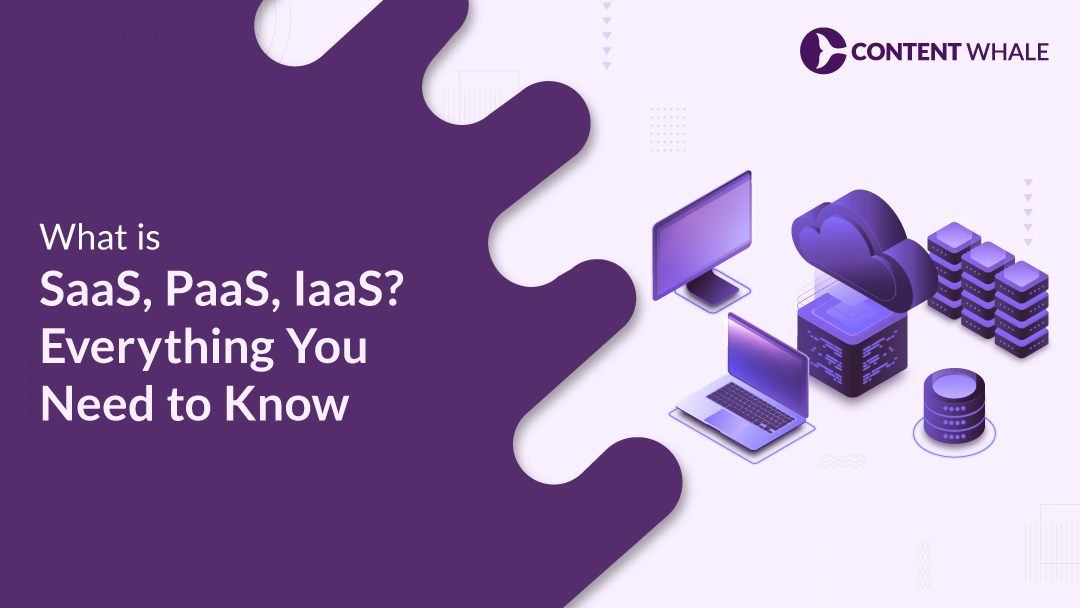Cloud computing has become an integral part of modern businesses, providing flexible solutions that adapt to different needs. Whether you’re running a small business or managing a large enterprise, understanding the core cloud service models—SaaS, PaaS, and IaaS—is essential for making the right technology decisions. These models, known as software as a service (SaaS), platform as a service (PaaS), and infrastructure as a service (IaaS), each serve a unique purpose and come with distinct advantages.
Businesses and developers are increasingly relying on cloud computing services to optimize operations, cut costs, and scale effectively. Choosing between SaaS, PaaS, and IaaS can significantly impact how companies operate. This guide will break down these cloud service models to help you understand their benefits, ideal use cases, and how they can fit into your organization’s strategy.
1. What is SaaS (Software as a Service)?

Software as a service (SaaS) is one of the most widely used cloud service models today. In SaaS, the software is hosted and managed by a third-party provider and delivered to users over the internet. Instead of downloading and installing the software on individual computers or networks, users can access it via a web browser from anywhere with an internet connection.
A) How SaaS Works
The SaaS model takes away the hassle of maintaining and updating software. All technical responsibilities, like managing servers, storage, and updates, are handled by the service provider. This makes cloud technology easy and accessible for businesses of all sizes, reducing the need for in-house IT management.
B) Popular SaaS Applications
There are countless examples of SaaS applications used daily by businesses and individuals alike:
- Google Workspace: A complete set of office tools including Gmail, Docs, and Drive, all delivered through the cloud.
- Microsoft 365: Offers cloud-based versions of popular applications like Word, Excel, and PowerPoint, along with cloud storage through OneDrive.
- Salesforce: A popular CRM platform that helps businesses manage customer relationships directly from the cloud.
C) Benefits of SaaS
SaaS benefits range from cost-efficiency to increased accessibility. Some key advantages include:
- Cost-effective: Businesses only pay for what they use, typically through a subscription model, eliminating hefty upfront costs.
- Accessibility: Employees can access the software from anywhere, promoting remote work and collaboration.
- No maintenance required: Updates and maintenance are handled by the provider, ensuring that businesses always use the latest version without any manual intervention.
D) Ideal Use Cases for SaaS
SaaS is an excellent choice for businesses that need software to perform standard tasks without dedicating resources to managing IT infrastructure. It’s ideal for:
- Small businesses that want to avoid the cost of dedicated IT staff.
- Enterprises that need a scalable, ready-to-use solution for various departments.
2. What is PaaS (Platform as a Service)?

Platform as a service (PaaS) offers a complete development and deployment environment in the cloud. It allows developers to build, test, and deploy applications without worrying about managing the underlying infrastructure like servers, storage, or databases. This cloud service model provides the tools and resources needed to create software applications, all within a controlled environment.
A) How PaaS Works
In a PaaS model, the service provider hosts everything—servers, storage, networking, and even development tools—so that developers can focus solely on coding and app development. This streamlines the process, reducing the need for extensive infrastructure management. It also enables faster deployment of applications, as developers can collaborate and experiment without the overhead of managing hardware.
B) Popular PaaS Platforms
Several PaaS examples illustrate how businesses and developers use this model to streamline their development process:
- Google App Engine: A fully managed platform that allows developers to build, deploy, and scale applications without managing infrastructure.
- Heroku: A popular platform that supports multiple programming languages, enabling developers to deploy applications directly from their codebase.
- Microsoft Azure: Azure’s PaaS offering allows developers to create applications using a range of programming languages, frameworks, and tools while benefiting from built-in cloud services.
C) Benefits of PaaS
The benefits of PaaS are particularly valuable for developers and businesses focused on rapid innovation:
- Faster time to market: With all necessary tools readily available in the cloud, developers can launch applications much faster.
- Cost efficiency: Since the provider manages the infrastructure, businesses save on hardware costs and ongoing maintenance.
- Simplified development: Integrated development tools and pre-built components allow developers to focus on coding and reduce the complexity of managing infrastructure.
D) Ideal Use Cases for PaaS
PaaS is particularly useful for:
- Developers looking to build and test applications in a streamlined environment.
- Startups that need to get to market quickly without spending time and resources on infrastructure.
- Enterprises needing a platform to build custom apps without the overhead of managing servers or networks.
3. What is IaaS (Infrastructure as a Service)?

Infrastructure as a service (IaaS) is a highly flexible and scalable cloud service model that provides essential computing resources over the internet. This model allows businesses to rent IT infrastructure—including servers, storage, and networking—on a pay-as-you-go basis. Unlike SaaS and PaaS, IaaS offers the most control over your resources, making it ideal for organizations that need to manage their own applications and systems.
A) How IaaS Works
In the IaaS model, a cloud provider delivers the virtualized hardware resources your business needs. Instead of purchasing physical hardware, you can rent virtual servers, storage, and networking equipment. This allows businesses to scale their infrastructure up or down based on demand without the expense of owning and maintaining hardware.
B) Popular IaaS Providers
Several leading IaaS solutions dominate the market, each offering robust infrastructure services to businesses of all sizes:
- Amazon Web Services (AWS): One of the most widely used IaaS platforms, AWS provides a vast range of services including compute power, storage, and databases.
- Microsoft Azure: Azure offers a comprehensive set of IaaS tools, enabling businesses to build, deploy, and manage applications across a global network of data centers.
- Google Cloud: Another leading IaaS provider, Google Cloud delivers powerful compute resources with advanced analytics and machine learning capabilities.
C) Benefits of IaaS
The benefits of IaaS make it an attractive option for enterprises requiring full control over their infrastructure:
- Scalability: Businesses can scale up or down as needed, without being tied to physical hardware constraints.
- Cost savings: By only paying for the resources used, companies can avoid the upfront costs and maintenance of physical hardware.
- Flexibility and control: IaaS provides complete control over the infrastructure, allowing businesses to configure their resources exactly as needed.
D) Ideal Use Cases for IaaS
IaaS is particularly well-suited for:
- Enterprises needing extensive customization and control over their infrastructure.
- Businesses experiencing fluctuating workloads, as they can easily scale resources up or down.
- Companies migrating legacy systems to the cloud while maintaining full control over their operating systems and applications.
4. SaaS vs PaaS vs IaaS: Key Differences
When evaluating cloud computing services, understanding the differences between SaaS, PaaS, and IaaS is essential to choosing the right model for your business. Each model offers different levels of control, flexibility, and responsibility, which can impact everything from cost to scalability.
A) Control and Flexibility
- SaaS provides the least control for businesses, as the service provider manages everything from infrastructure to software. Users only control how they interact with the software. This is ideal for businesses looking for ready-to-use applications without worrying about infrastructure or maintenance.
- PaaS offers more flexibility by allowing businesses to build, develop, and manage their own applications on a platform provided by the cloud service provider. The infrastructure and runtime environment are still managed by the provider, but developers can customize and control the applications they create.
- IaaS offers the most control and flexibility. Businesses rent virtualized infrastructure and manage their own applications, middleware, and operating systems. This model is perfect for enterprises that need to tailor every aspect of their infrastructure and manage large, complex environments.
B) Cost Structure
- SaaS generally follows a subscription-based model, where users pay a recurring fee for access to software. This is cost-effective for businesses that don’t want to invest in hardware or software management.
- PaaS often uses a usage-based pricing model. Businesses pay for the resources they consume, such as development tools, storage, and networking, which can scale up or down based on demand.
- IaaS follows a pay-as-you-go model, where businesses pay only for the infrastructure they use. This is ideal for businesses with variable workloads or those that want to avoid the capital expenditure of purchasing and maintaining hardware.
C) Scalability
- SaaS scales easily for businesses that need to add or remove users without making changes to the underlying infrastructure. The provider handles all scaling issues.
- PaaS allows scalability at the application level, making it easier for developers to adjust resources for their specific apps.
- IaaS provides the highest level of scalability. Businesses can increase or decrease their computing resources, storage, and networking based on real-time demand, making it ideal for companies with fluctuating workloads.
D) Security and Responsibility
- SaaS offers robust security, but the control over data security and compliance is in the hands of the service provider. Businesses must trust that the provider meets necessary security standards.
- PaaS involves more responsibility on the part of the developer to ensure that the applications built on the platform are secure. The platform provider handles the security of the infrastructure.
- IaaS places the most responsibility on the business. While the cloud provider ensures infrastructure security, the organization must manage and secure everything above the infrastructure layer, including data, applications, and operating systems.
E) Comparison Table:
| # | Cloud Model | Control | Responsibility | Scalability | Cost |
| 1 | SaaS | Low | End-user only | High | Subscription-based |
| 2 | PaaS | Medium | Developer | High | Usage-based |
| 3 | IaaS | High | Full infrastructure | Very high | Pay-as-you-go |
5. Benefits of Cloud Service Models
Each cloud service model—SaaS, PaaS, and IaaS—offers unique advantages that can benefit businesses of all sizes. Whether you need simple software access, a development platform, or full control over your infrastructure, these models provide scalable, cost-effective solutions.
A) Shared Benefits of Cloud Services
Regardless of the specific model, cloud computing services offer several common advantages:
- Cost savings: By leveraging cloud infrastructure, businesses can significantly reduce the upfront costs of purchasing hardware and maintaining software. You pay for what you use, often on a subscription or usage-based model, which can be more cost-effective than traditional IT solutions.
- Global accessibility: One of the most attractive features of cloud services is the ability to access applications and data from anywhere, as long as there’s an internet connection. This enables seamless remote work and global collaboration.
- Automatic updates: With cloud services, updates and maintenance are handled by the provider, ensuring that businesses always have access to the latest technology without manual intervention.
B) SaaS Benefits
SaaS benefits are particularly focused on ease of use and accessibility:
- Ease of deployment: SaaS applications can be accessed instantly without the need for complex installation or configuration.
- Scalability: Adding new users or features is easy, making SaaS ideal for growing businesses.
- Reduced IT burden: Since the provider manages everything, businesses don’t need dedicated IT staff to handle software maintenance or updates.
C) PaaS Benefits
For developers and businesses focused on application development, PaaS offers several key advantages:
- Faster development cycles: PaaS provides all the tools developers need to build, test, and deploy applications quickly. This reduces time to market and enables more agile development processes.
- No infrastructure management: With the provider handling servers, storage, and networking, developers can focus purely on building applications.
- Collaboration: PaaS platforms enable multiple developers to work on the same project in real time, streamlining the development process.
D) IaaS Benefits
IaaS solutions are ideal for organizations that need flexibility and control over their infrastructure:
- Full control: IaaS provides businesses with the ability to manage and configure their own infrastructure, from servers to storage, ensuring that all systems are tailored to specific business needs.
- Scalability: Businesses can easily scale their infrastructure up or down based on demand, making IaaS perfect for companies with variable workloads.
- Cost-efficiency: By renting virtualized hardware instead of purchasing physical servers, businesses save on capital expenditures and reduce ongoing maintenance costs.
E) Choosing the Right Model
The best cloud service model depends on your business’s needs:
- SaaS is ideal for organizations looking for ready-made software solutions without the hassle of management.
- PaaS works best for developers and businesses focused on building and deploying custom applications.
- IaaS suits enterprises that require full control over their IT environment and need scalable, flexible infrastructure.
6. Real-World Examples and Use Cases
Understanding how SaaS, PaaS, and IaaS work in practice can help businesses decide which model is best suited for their needs. Many leading companies rely on these cloud computing services to streamline operations, scale faster, and reduce infrastructure costs. To ensure their teams are equipped to effectively utilize these technologies, many businesses are offering their employees training using resources like Microsoft AZ-900 Exam Dumps, providing hands-on experience and expertise in cloud computing.
A) SaaS Use Cases
SaaS is the go-to model for businesses seeking readily available applications without the burden of managing infrastructure. Here are a few examples of businesses leveraging software as a service:
- Salesforce: Salesforce is a widely used CRM platform that helps businesses manage customer relationships, sales pipelines, and marketing efforts. It provides powerful tools for both small and large businesses and allows teams to collaborate seamlessly from anywhere.
- Zoom: A prime example of a SaaS solution, Zoom offers video conferencing software that is easy to deploy and use. Its popularity skyrocketed due to remote work, demonstrating how SaaS can quickly scale to meet global demand without additional infrastructure.
- Slack: This messaging platform enables team communication and collaboration through a cloud-based solution. Businesses use Slack to share files, manage projects, and keep team members connected, all without any need for server management.
B) PaaS Use Cases
PaaS is especially useful for developers who need an environment to create, test, and deploy applications. Below are examples of companies using platform as a service for rapid application development:
- Shopify: As a leading eCommerce platform, Shopify allows businesses to set up online stores quickly and easily. Shopify also offers a PaaS model for developers who want to create custom themes, apps, or integrations for online retailers.
- Netflix: Netflix uses Google Cloud Platform (GCP) and Amazon Web Services (AWS) as part of its PaaS strategy to build and test applications efficiently. The platform enables Netflix to handle massive data streams and process millions of video streams in real time, ensuring uninterrupted service for its users.
- Heroku: A popular PaaS example, Heroku simplifies the process of deploying applications, offering a managed environment where developers can build, run, and scale apps in the cloud with minimal infrastructure management.
C) IaaS Use Cases
IaaS is ideal for businesses that need full control over their infrastructure and want to avoid the capital costs of owning physical hardware. Here’s how leading companies use infrastructure as a service:
- Netflix: Netflix is also an excellent example of a business leveraging IaaS solutions. By using Amazon Web Services (AWS), Netflix manages to store and stream vast amounts of data to users globally. AWS provides the scalable infrastructure Netflix requires to handle fluctuating demand while maintaining reliability.
- Airbnb: As one of the largest online marketplace platforms for lodging, Airbnb uses Amazon Web Services (AWS) to host its services. The IaaS model allows Airbnb to scale its infrastructure up or down based on seasonal demand and user traffic, ensuring a smooth experience for millions of customers.
- NASA: NASA uses Google Cloud and AWS for its IaaS needs. These cloud platforms enable NASA to store and analyze massive datasets related to space exploration while maintaining full control over its infrastructure. By leveraging IaaS, NASA avoids the costly maintenance of on-premise hardware.
D) Choosing the Right Model for Your Business
Each of these cloud models—SaaS, PaaS, and IaaS—caters to different business needs:
- SaaS is perfect for companies that want quick access to applications without dealing with infrastructure.
- PaaS suits developers looking for a streamlined development environment.
- IaaS works best for enterprises needing full control over their infrastructure.
Conclusion

Understanding the differences between SaaS, PaaS, and IaaS can help businesses make informed decisions about which cloud computing services are right for their specific needs. Each cloud model offers unique advantages that cater to various operational goals.
- SaaS is ideal for companies that want fast, cost-effective access to software without worrying about infrastructure. Its benefits include easy deployment, accessibility from anywhere, and reduced IT management overhead, making it perfect for businesses looking to simplify software management.
- PaaS empowers developers with tools to build, test, and deploy applications without managing the underlying infrastructure. It accelerates innovation by streamlining development processes, allowing businesses to bring products to market faster. Popular PaaS examples like Google App Engine and AWS Elastic Beanstalk show how PaaS can reduce complexity while offering a flexible, scalable environment for app development.
- IaaS, offering the most control over IT infrastructure, is best for organizations with fluctuating workloads that need scalable computing resources. IaaS solutions such as Amazon Web Services (AWS) and Microsoft Azure provide businesses with the flexibility to manage their own infrastructure while still benefiting from the cloud’s scalability.
______
This blog is crafted by Content Whale, your trusted partner for high-impact, SEO-optimized content that delivers measurable results. If you’re looking to elevate your brand, boost your rankings, and outpace the competition, we’re here to help. Contact us today, and let’s create content that drives success and takes your business to the next level.
FAQs
1. What are the main differences between SaaS, PaaS, and IaaS?
The primary distinction between SaaS, PaaS, and IaaS lies in the control and management each model offers. SaaS (Software as a Service) allows businesses to use software over the internet without managing underlying infrastructure, making it ideal for applications like email or CRM systems. PaaS (Platform as a Service) offers a platform where developers can build and deploy applications without managing hardware, while IaaS (Infrastructure as a Service) provides virtualized computing resources like servers and storage for businesses to build and manage their own infrastructure.
2. Is SaaS better for small businesses?
Yes, SaaS is often the most suitable for small businesses because it offers ready-made software solutions without the need for complex setup or infrastructure. It’s a cost-effective choice, providing subscription-based access to essential tools like accounting software, CRMs, or email systems. Small businesses benefit from easy scalability and reduced upfront investment.
3. Can I switch between SaaS, PaaS, and IaaS?
Yes, businesses can adopt different cloud models or switch between them depending on their evolving needs. Many companies use a combination of SaaS, PaaS, and IaaS for different aspects of their operations. For example, you might use SaaS for day-to-day applications, PaaS for app development, and IaaS for handling infrastructure as your company scales.
4. What are the key benefits of using cloud computing services?
The main benefits of cloud computing services include scalability, cost savings, and improved accessibility. Whether using SaaS, PaaS, or IaaS, businesses can scale up or down based on demand, reduce hardware and maintenance costs, and allow remote access from anywhere with an internet connection. Additionally, cloud services offer automated updates and robust security measures.
5. Which cloud service model is best for developers?
PaaS is the most developer-friendly cloud service model, as it provides a complete platform for building, testing, and deploying applications without managing the underlying infrastructure. With PaaS, developers can focus on coding while the platform handles the hardware and software environment.



